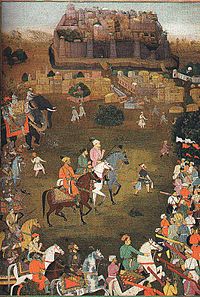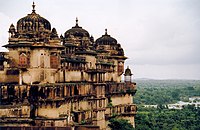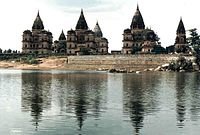Orchha State
| Orchha State | |||||||
|---|---|---|---|---|---|---|---|
| 1501–1947 | |||||||
 Orchha State in the Imperial Gazetteer of India | |||||||
| Capital | Orchha, Tikamgarh | ||||||
| Area | |||||||
• 1908 | 5,400 km2 (2,100 sq mi) | ||||||
| Population | |||||||
• 1908 | 321,364 | ||||||
| Government | |||||||
| Raja | |||||||
• 1501–1531 (first) | Rudra Pratap Singh | ||||||
• 1930–1950 (last) | Vir Singh II | ||||||
| History | |||||||
• Established | 1501 | ||||||
| 1947 | |||||||
| |||||||
| Today part of | India | ||||||
Orchha State (also known as Urchha, Ondchha and Tikamgarh)[1] was a kingdom situated in the Bundelkhand region and later a princely state in British India. The state was ruled by Bundela clan of Rajputs.[2] It was located within what is now the state of Madhya Pradesh.
The Chaturbhuj Temple was built by the Queen of Orchha,[3] while the Raj Mandir was built by Madhukar Shah during his reign, 1554 to 1591.[4] In 1811, during the period of Company Rule in India, it became part of the Bundelkhand Agency within the Central India Agency; after the independence of India in 1947, it acceded to the Union of India, in 1950.
History[edit]
Before company rule[edit]

Orchha State was founded in 1531 by the Rudra Pratap Singh, who became its first king. He had a fortress at Garh Kundar and took advantage of the politically unstable environment of the time to make territorial gains. He moved to Orchha on the banks of the river Betwa and established it as his new capital. He died in the same year.[5]
Rudra Pratap Singh was succeeded by his son, Bharatichand, who died without leaving an heir in 1554 and was in turn succeeded by his younger brother, Madhukar Shah.[5] Both Bharatichand and Madhukar had to deal with attacks, organised under the Afghan Islam Shah Suri (r. 1545–53) and the Mughal emperor Akbar (r. 1556–1605). Events involving the former were noted by the court poet Keshavdas and those involving Madhukar, who had to relinquish lands to Akbar in 1577 and 1588, were recorded in the Akbarnama. Madhukar's position had become so precarious in the 1570s that he agreed to Orchha becoming a tributary state and to enlistment of himself and his family in the service of the Mughal empire, but another near-contemporary historian, `Abd al-Qadir Bada'uni, records him as a rebel in 1583.[6]

During the rule of the Mughal emperor Jahangir, his vassal, Vir Singh Deo, was ruler of the Orchha area.[7] His reign ended in either 1626[8] or 1627 and it was during this period that Orchha reached its zenith in both political power and architectural splendour. Examples of the architecture include the Jahangir Mahal (built ca. 1605) and the Sawan Bhadon Mahal.[7]
In the early-17th century, Raja Jhujhar Singh rebelled against the Mughal emperor but was defeated. Shah Jahan placed the former raja's brother on the throne in 1641. Orchha was the only Bundela state not entirely subjugated by the Maratha Confederacy in the 18th century.[8]

The town of Tehri, Tikamgarh, about 52 miles (84 km) south of Orchha, became the capital of Orchha state in 1783, and is now the district town; Tehri was the site of the fort of Tikamgarh, and the town eventually took the name of the fort.[1]
-
Jahangir Mahal, Orchha
-
Memorial Chhatris of the ruler of Orchha, on the bank of the Betwa River.
-
Lakshmi Temple, Orchha
During the British era[edit]
On 23rd December 1812, Orchha king made treaty of alliance with Britishers. Hamir Singh, who ruled from 1848 to 1874, was elevated to the style of Maharaja in 1865. During his reign the allied forces of Orchha and Datia invaded Jhansi in 1857 intending to divide the Jhansi territory between them. However they were defeated by Rani Lakshmibai's army and her allies in August 1857. (She intended at this time to hold Jhansi on behalf of the British who had no forces there at the time.)[9] Maharaja Pratap Singh (born 1854, died 1930), who succeeded to the throne in 1874, devoted himself entirely to the development of his state, himself designing most of the engineering and irrigation works that were executed during his reign.
In 1908, the boundaries of the state lay between 24° 26′ and 25° 40′ North and 78° 26′ and 79° 21′ East. It formed a part of the Bundelkhand Agency and had an area of 2,080 square miles (5,400 square kilometres).[1] The 1901 Census of India recorded a population of 321,634.[10] It was the oldest and highest in rank of all the Bundela states,[8] with a 15-gun salute, and its maharajas bore the hereditary title First of the Prince of Bundelkhand.
Vir Singh, Pratap Singh's successor, merged his state with the Union of India on 1 January 1950. The district became part of Vindhya Pradesh state, which was merged into the state of Madhya Pradesh in 1956.
Rulers[edit]


Rajas[edit]
Prior to Company Rule, the rulers of Orchha all held the title of Raja. They were:
- Rudra Pratap Singh (1501–1531)[11]
- Bharatichand (1531–1554)[5]
- Madhukar Shah (1554–1592)[12]
- Ram Shah (1592–1605)[12]
- Vir Singh Deo (also spelled Bir Singh Deo) (1605–1626/7)[4][8]
- Jhujhar Singh (1626/7–1635)[8] (brother of Hardaul Singh)
- Devi Singh (1635–1641) (brother of Jhujhar Singh)
- Pahar Singh (1641–1653)
- Sujan Singh (1653–1672)
- Indramani Singh (1672–1675)
- Jaswant Singh (1675–1684)
- Bhagwat Singh (1684–1689)
- Udwat Singh (1689–1735)
- Prithvi Singh (1735–1752)
- Sanwant Singh (1752–1765)
- Hati Singh (1765–1768)
- Man Singh (1768–1775)
- Bharti Singh (1775–1776)
- Vikramajit Mahendra (1776–1817)[8]
- Dharam Pal (1817–1834)[8] Queen Ladai Sarkar was his wife
- Taj Singh (1834–1842)[8]
- Surjain Singh (1842–1848)[8] (Queen Ladai Sarkar ruled at this time)
- Hamir Singh (1848–1865)[8]
Maharajas[edit]
During the British era, initially under Company Rule and then as a part of the British Raj, the title of Raja was in use until 1865, when it was replaced with that of Maharaja. The rulers were:
- Hamir Singh (1865–1874)[8]
- Pratap Singh (1874–1930)[8]
- Vir Singh II (4 March 1930 – acceded 1 January 1950) (b.1899 – d.1956)
Titular Maharajas[edit]
- Vir Singh II (1 January 1950 – 1956)
- Devendra Singh (1956 – 1978)
- Madhukar Shah (1978 – present)
Queen of Orchha[edit]
Rajput Kshatriya Warrior Queen of Orchha Veerangana Queen Rani Ladai Dulaiya Sarkar Ju Dev Bundela Sahiba
Other name Rani Ladai Sarkar
Maratha Empire[edit]
At one time entire Bundelkhand was under Orchha state. from here the main ruler was Rajput Bundela Raja. Maharaja in 1730 Chhatrasal Bundela gave away the third part of his Bundelkhand state. Gave it to Bajirao Peshwa I. Jhansi state also in it Was. Before that Jhansi was the city of the kings of Orchha. of Marathas After the occupation, the boundaries of Orchha state became extremely narrow. Went Datia and Orchha due to increasing power of Marathas Was against Jhansi. At that time, Naroshankar, the Subhedar of Marathas. Driven away the Bundela commander from Jhansi and liberated Jhansi. Lakhs of rupees were recovered from Orchha as penalty. As a result of which the rulers of Orchha and Datia became the kings of Jhansi. Had hatred towards. Time in the Maratha Empire Jhansi Central India Hugh Rose himself said that it was the most prosperous city of The book has been written.
Bundela Dynasty[edit]
On 26 December 1812, the British and Orchha King Maharaj Vikramjit Singh Ju Dev Bundela signed a treaty due to which Orchha did not fall into the hands of the Marathas. After the death of Maharaj Vikramjit, his son Dharampal Bundela became the king. Dharampal died childless. Then Vikramjit's brother Tejashwi and his son Sujan Singh became kings one after the other. Maharani Ladai Dulaiya Sarkar Ju Dev Bundela, wife of deceased Dharampal, was extremely ambitious. He divided the kingdom with Sujan Singh. And adopted a son named Hamir Singh. Sujan Singh in front of the sharp mind of Maharani Ladai Dulaiya Sarkar.
Sujan Singh was defeated by the sharp intelligence of Maharani Ladai Dulaiya Sarkar and went to the shelter of Jhansi King Maharaj Gangadhar Rao in 1851-53. In 1854, the British Government had approved the adopted son of Queen Ladai Dulaiyya Sarkar as the successor. Meanwhile, it was decided by the British that for the old assistance and to repay the loan, the annual rent of Tehri Jagir of Orchha of Rs. 6000 should be given to Jhansi State. The queen of Orchha used to pay this tax every year in the name of her adopted son. Due to which Orchha's hatred towards Jhansi became more intense.
Jhansi War[edit]
In 1853, King Gangadhar Rao Newalkar of Jhansi died. At that time the border of Jhansi was unsafe. Taking advantage of this, in 1857, Queen Ladai Dulaiyya Sarkar of Orchha got ready to take revenge for the old hatred and insult. Rani Ladai Dulaiya Sarkar Ju Dev reached Jhansi city with 20,000 army of Orchha and war material, conquering various parts of Jhansi. Mauranipur Pargana was conquered on 10 August 1857. Queen Lakshmibai had informed the British about the misdeeds of the neighboring states. He installed the British Union Jack flag on the Jhansi Fort given to Raja Ramachandra Rao by William Batting.
Queen Ladai Dulaiya Sarkar and Commander Nathe Khan were at that time in the camp on the banks of river Betwa. Maharani Lakshmibai wrote a letter to British officer Erskine asking for help. Queen Ladai Dulaiya Sarkar and Commander Nathe Khan were at that time in the camp on the banks of river Betwa. Maharani Lakshmibai wrote a letter to British officer Erskine asking for help. This letter was written on 2 October 1857. The proof that Erskine had received this letter is present in the government archives. But the British did not help Queen Lakshmibai. It was Erskine who handed over the rule of Jhansi to Rani Laxmibai. And he himself had not interfered in this matter. While declaring Rani Laxmibai an accused in the Jhokon Bagh massacre, while giving a report to her superiors, she said that the Rani of Jhansi is a rebel and the cause of Orchha deserves full support. Orchha Rani is a friend of the British.
Queen Lakshmibai herself got ready for war. Meanwhile, under the leadership of Rani Ladai Sarkar, Nathe Khan sent a letter to Queen Lakshmibai asking her to leave the fort and the city. Queen Lakshmibai called the court and started preparations for war. The Queen declared war on Nathe Khan in response.
At that time Jhansi's army was not large. Raghunath Singh, Jawahar Singh, Rao Dulhaju, Ghaus Khan, Lalabhau Bakshi, Khuda Baksh, Nari Sena and especially Manvati Devi were prominent in the Jhansi army. Peshwa era cannons were prepared. Bhavani Shankar, strong lightning, Naaldar, enemy destroyer, thunderous cannon were ready. In October, the queen of Orchha brought her army. A fierce battle took place and the areas around Jhansi were captured by the Rani Ladai Sarkar. She moved towards Jhansi city and fort. Maharani Lakshmibai herself jumped into the war. Rani Ladai Sarkar and commander Nathe Khan had to flee in front of Queen Lakshmibai's tactics. On 23 October 1857, Maharani Lakshmibai was victorious in this war. Mauranipur was captured by Rani Laxmibai.
Jhansi Orchha Treaty[edit]
In November 1857, the Commander of Orchha Nathe Khan arrived again under the leadership of Rani Ladai Sarkar. There was such an attack by Rani Laxmibai's cannons from Orchha Gate that Nathe Khan's army started running away. Then Jhansi's brave lady Manvati Devi Haihayavanshi demonstrated her bravery and courage in such a way that Nathe Khan Khan's army went out of Jhansi border.
On 30 November 1857, due to the mediation of Jahangirdar Choubey of Kalinjar and Banpur King Raja Mardan Singh Ju Dev, a treaty was signed between Queen Lakshmibai and Queen Ladai Dulaiya Sarkar of Orchha. Both of them started loving each other like sisters.
In August and October of 1857, Orchha was attacked by Rani Ladai Sarkar. And then in November, the army of commander Nathe Khan attacked under the leadership of Ladai Sarkar. At that time Rani Laxmibai's authority was limited only to Jhansi city. After the treaty in December, Maharani Lakshmibai gained control over the entire Jhansi region. The areas captured by Orchha Rani were returned to Rani Lakshmibai. Jhansi suffered so much damage due to the battle of Orchha that Jhansi was defeated in the battle of March 1858. And the queen left the fort and went to Kalpi.
It is said that Maharani Ladai Dullaiya Sarkar of Orchha had secretly helped Rani Lakshmibai in the freedom struggle. Rani Ladai Sarkar's name is rarely mentioned in history. For this reason there is no evidence of his birth, death and independence war.
But Maharani Ladai Dullaiya Sarkar is a proud part of the entire Bundelkhand and Orchha history.
Postal history[edit]

Postage stamps for the state were prepared for use in 1897 but were never issued. The first Orchha State stamps were issued in 1913 (half-anna and one anna); in 1914 there was another issue of four stamps (half-anna to four annas). The third issue was in 1939 when a range of stamps bearing the maharajah's portrait were issued which included denominations from half-anna to eight annas and one rupee to ten rupees.[13]
Separate stamps were discontinued on 30 April 1950 after the state was merged with the Union of India early that year.
Coinage[edit]
Orchha minted coins in copper and silver. The currency was known as Gaja Shahi because it most commonly bore the symbol of a mace (gaja) on the reverse. The mace symbol was imitated on coins issued by Datia State.[8]
See also[edit]
References[edit]
- ^ a b c Imperial Gazetteer of India. Vol. 19. Clarendon Press. 1908. p. 241.
- ^ Mehta, Jaswant Lal (2005). Advanced Study in the History of Modern India 1707–1813. Sterling Publishers. p. 105. ISBN 978-1-93270-554-6.
- ^ "Chaturbhuj Temple, Orchha". British Library. Retrieved 26 March 2015.
- ^ a b "Fort and Palace at Orchha". British Library. Retrieved 26 March 2015.
- ^ a b c Busch, Allison (2011). Poetry of Kings: The Classical Hindi Literature of Mughal India. Oxford University Press. p. 29. ISBN 978-0-19976-592-8.
- ^ Busch, Allison (2011). Poetry of Kings: The Classical Hindi Literature of Mughal India. Oxford University Press. pp. 29, 258. ISBN 978-0-19976-592-8.
- ^ a b "Sawan Bhadon Palace, Orchha". British Library. Retrieved 26 March 2015.
- ^ a b c d e f g h i j k l m Michael, Thomas (2009). Cuhaj, George S. (ed.). Standard Catalog of World Coins, 1801-1900 (6th ed.). Krause Publications. p. 728. ISBN 978-0-89689-940-7.
- ^ Edwardes, Michael (1975) Red Year. London: Sphere Books, p. 117
- ^ Great Britain India Office. The Imperial Gazetteer of India. Oxford: Clarendon Press, 1908
- ^ Busch, Allison (2011). Poetry of Kings: The Classical Hindi Literature of Mughal India. Oxford University Press. p. 23. ISBN 978-0-19976-592-8.
- ^ a b Busch, Allison (2011). Poetry of Kings: The Classical Hindi Literature of Mughal India. Oxford University Press. p. 46. ISBN 978-0-19976-592-8.
- ^ Stanley Gibbons' Simplified Stamp Catalogue (24th ed.). Stanley Gibbons Ltd. 1959. p. 1063.
- "Discovery of monuments at Orchha". Economic Times. 20 September 2009.
External links[edit]
 Media related to Orchha State at Wikimedia Commons
Media related to Orchha State at Wikimedia Commons- "Orchha Journal; See the Ruins (Before They Vanish)". New York Times. 18 January 1992.
- States and territories established in 1501
- States and territories disestablished in 1947
- Princely states of Bundelkhand
- States and territories established in 1531
- States and territories disestablished in 1950
- Tikamgarh district
- Rajput history
- 1531 establishments in India
- 1950 disestablishments in India
- Orchha
- Gun salute princely states
- Princely states of Madhya Pradesh






